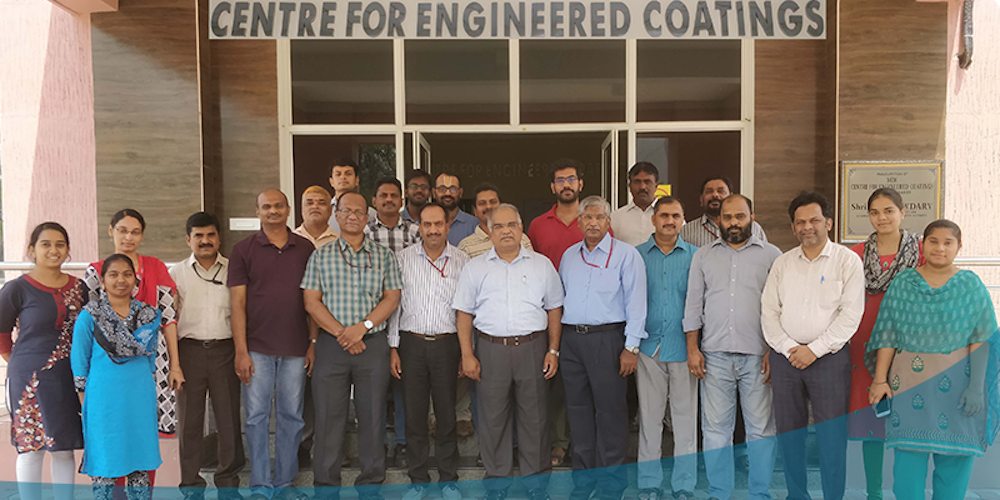New but Cheap Indian Iron Aluminide Coatings Four Times More Corrosion Resistance than Steel

Indian scientists have developed low-cost Fe-based intermetallic powders that can be used as a corrosion-resistant coating for materials exposed to harsher environments like high temperature in thermal power plants where oxidation, corrosion, and wear and tear takes place simultaneously.
The coatings showed 4 times increased corrosion resistance in the aqueous corrosive media than the mild steel.
Wear and corrosion cause major damage over a range of service temperatures. Hence, there is a need to protect the component surface with a suitable material for enhanced economic viability. Such surface coating on a turbine blade can enhance the service life and hence increases the operation hours of the turbine.
At present, thermally sprayed Chromium Carbide-Nickel Chromium Powder and Tungsten Carbide-Cobalt (Cr3C2-NiCr and WC-Co) (cermet) coatings have been widely used for superior wear and high-temperature oxidation resistance applications like thermal power plant turbine blades, aerospace engine blades, landing gear shafts, steel rolls in the paper industry. This is mainly attributed to their hardness, toughness, and better corrosion resistance under exposure to up to 550oC in the case of WC-Co coatings and up to 850oC for CrC-NiCr coatings.
However, the powders are expensive due to the presence of Co and Ni elements. Besides, Cr is toxic in its hexavalent state. Replacement of these coatings with simple Fe-based coatings with novel microstructural constituents is very promising. In this regard, iron-based solid phases involving two or more metallic or semi metallic elements (intermetallics) can play a major role owing to their hardness and better corrosion resistance. However, their deployment is rather restricted by low ductility.
A team of scientists at the Centre for Engineered Coatings (CEC), International Advanced Research Centre for Powder Metallurgy & New Materials (ARCI), an autonomous R&D Centre of the Department of Science and Technology (DST), has addressed this by synthesizing Fe-based intermetallic powders and utilized the same for depositing the coatings using detonation spray coating (DSC) technique.
Besides, ARCI has developed gas atomized Fe aluminide powder and deposited it on mild steel substrates by DSC without any cracks or spalling. The coatings have demonstrated 4 times increased corrosion resistance in the aqueous corrosive media than the mild steel.
The coatings exhibited better corrosion resistance when Cr and Al are in a solid solution with Fe than in the Fe –rich phases. The coatings have demonstrated an increased wear resistance by 30-40% than the mild steel under solid particle erosion wear mode, implying that FeAlCr coatings can be used for high-temperature erosion resistance applications. More studies are currently underway to qualify the FeAlCr coatings for fireside corrosion protection of boiler components in collaboration with the NTPC, to enhance boiler life.
It may be noted that as far as the field of surface modification technologies are concerned, India has matured significantly in recent years. The conspicuous upward trend in the adoption of surface modification technologies by the Indian industry has also been catalysed by several initiatives taken by the Government of India’s Department of Science & Technology (DST).
Hyderabad-based ARCI scientists have played a prominent role in piloting these initiatives and the organization has consistently tried to identify coating technologies of national relevance and consciously pursue those that are unavailable elsewhere in the country.
Over the years, ARCI has successfully projected itself as a leader in the field of surface modification. ARCI’s Centre for Engineered Coatings (CEC) has been engaged in developing a wide spectrum of appropriate surface modification technologies to assist the Indian industry in meeting the challenge of enhancing the durability and performance of components operating in adverse environments. The efforts of CEC have focused on eventually transferring relevant technologies to private entrepreneurs in a cost-effective manner.
Several coating technologies are being simultaneously pursued by the Centre for Engineered Coatings in an effort to offer a range of quality and cost to the potential user industries. Some of these have matured and already successfully transferred to the industry while yet other exciting technologies are presently on the anvil.
Some of the major coating technologies established at CEC:
– Detonation spray coating
– Cold spray coating
– Axial Plasma Spray Coating
– Activated Combustion high-velocity Air-Fuel Spray Coating
– Solution precursor plasma spray coating
– Electron beam physical vapour deposition
– Cathodic arc physical vapour deposition
– High Power Impulse Magnetron Sputtering (HiPIMS) facility
– Micro arc oxidation
– Pulsed electro-deposition coatings
– Slurry coating facility
– High temperature compliant sealant for metal-ceramic joining.
– In-organic copper paint.



